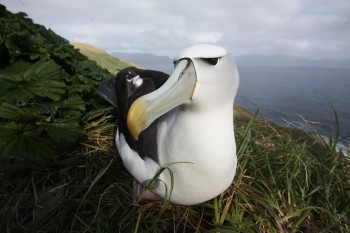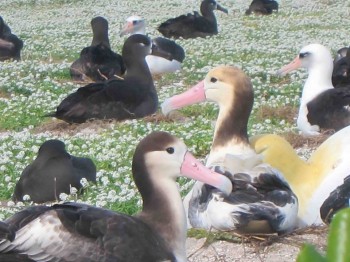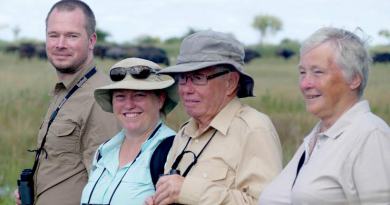The 6th International Albatross and Petrel Conference (IAPC6) was held in Barcelona Catalonia, Spain, from 19-23 September 2016 in the historic Paranimf (Paranymph) of the University of Barcelona. About 150 researchers from all over the World, including 50 MSc and PhD students, attended. Among the delegates were ACAP's Science Officer and several members of its Advisory Committee and working groups.
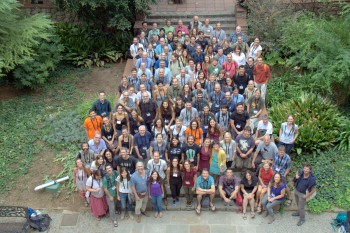
IAPC6 attendees in Barcelona
Approximately 100 oral presentations were given and 51 posters displayed, with notably more offerings on studies on the smaller, burrowing procellariiforms (especially shearwaters) than during the previous five albatross and petrel conferences. Heading each oral session was one of 12 keynote presentations and there were two poster sessions.
Hadoram Shirihai spoke on the discovery and rediscovery of six petrel species at the opening reception and Frank Zino closed the conference with an account on conserving the Endangered Zino’s Petrel Pterodroma madeira. Awards were given to students to recognize excellence in oral and poster presentations at the closing ceremony.
Two different workshops took place before the Conference, entitled “Data Challenge on Behavioural Annotation” and “GLS data analysis: state of the art and future”.
With general agreement that IAPC6 under the Chair of Jacob González-Solís and his Local Organizing Committee was an enjoyable and well-organized meeting, thoughts will now start to turn to where (and when) next? It seems that an offer to host an IAPC7 in four to five years’ time is likely to be welcomed by the procellariiform community.
Oral and poster presentations on ACAP-listed species and bycatch issues are given below by presenting author and title. Click here to access the programme and abstracts booklet. Videos of the opening and closing talks, keynote presentations and workshops may also be found on the IAPC6 website here.
ORAL PRESENTATIONS
Angel, A. Tristan Albatrosses need more protection at sea
Arcos, J.M. A new scenario for Mediterranean fisheries: where do seabirds fit?
Arcos, J.M. Understanding episodic bycatch of shearwaters in the Western Mediterranean; the Seabird Task Force in Europe
Beck, J. Sex, age and body condition of albatross caught as bycatch in Hawaiian (2010-2015) and Alaskan longline fisheries (2007, 2009-2014)
Boersch-Supan, P.H. Unravelling physiological and ecological determinants of albatross chick growth and survival
Bond, A.L. Integrated population modelling of Atlantic Yellownosed Albatross using long-term data
Bonnet-Lebrun, A-S. Quantifying individual specialization through multidimensional niches: a case study of black-browed albatrosses
Boulinier, T. Infectious diseases as a threat to albatrosses and petrels: from basic immuno-ecology to perspectives for conservation
Bourret, V. Testing a vaccine against avian cholera in albatrosses: combining observational and experimental data in a remote seabird community
Bretagnolle, V. A quick overview of the forthcoming “Albatrosses, petrels and shearwaters of the world: a handbook to their taxonomy, identification, ecology and conservation”
Carle, R. First steps for mitigating bycatch of Pink-footed Shearwaters Ardenna creatopus: Identifying overlap of foraging areas and fisheries in Chile
Carneiro, A.P.B. Sex differences in movements, distribution and habitat use of white-capped albatrosses from New Zealand during the nonbreeding period
Clay, T.A. Finding your niche: the fitness consequences of early life movements and specialization in individual albatrosses
Collet, J.M. Beyond chances of encounters: exploring bird decision making to understand the determinants of seabird-fisheries interactions
Cortés, V. Seabird bycatch assessment and mitigation tests in the demersal longline fleet from the Western Mediterranean coast
Crossin, G.T. Circumnavigations, spatial segregation, and activity of nonbreeding albatrosses, and their physiological correlates
Debski, I. Prioritising research and management of at-sea threats to New Zealand seabirds
De Grissac, S. Early life foraging: behavioural response of newly fledge albatrosses to environmental conditions
Desprez , M. Linking demography and foraging behaviours in a long-lived seabird, the black-browed albatross
Fitzgerald, S.M. Performance and challenges of electronic monitoring for fisheries monitoring and seabird bycatch
Fitzgerald, S.M. Seabird bycatch monitoring, conservation achievements, and ongoing work in North Pacific groundfish fisheries
Gianuca, D. Influence of fisheries, climate and environmental cycles on the survival and breeding success of giant petrels
Gianuca, D. Seabird bycatch and adoption of bycatch mitigation measures in pelagic longline fisheries off southern Brazil
González-Solís, J. Ban of discards will likely increase Mediterranean seabirds’ bycatch
Hansen, A.M.K. Successful mitigation of impacts to Bonin petrel (Pterodroma hypoleuca) and Laysan albatross (Phoebastria immutabilis) chicks during emergency maintenance work on Midway Atoll
Hodum, P. Engaging local communities to advance seabird conservation: lessons from a decade of community based projects
Kroeger, C.E. Influence of corticosterone and foraging behaviour on patterns of mass gain in two sympatric albatross species
Krüger, L. Tomorrow never knows: projected distributions of albatrosses, petrels and fisheries in response to changing climate in the Southern Ocean
López, V. Advancing conservation of Pink-footed Shearwaters (Ardenna creatopus) through community outreach and education
Louzao, M. Foraging in productive marine grounds when human activity comes into play: assessing sensitivity to longline bycatch in a critically endangered species [Balearic Shearwater]
McInnes, J.C. Methods to assess albatross diet past, present, and future – assessing priorities across their range
McInnes, J.C. A global assessment of black-browed and Campbell albatross diet using DNA techniques
Morandini, V. Physiological conditions of parent and offspring Blackbrowed Albatrosses
Nishizawa, B. Foraging behavior of Laysan albatrosses: feeding on floating dead squid during daytime
Orben, R. North Pacific albatrosses use predictable moulting areas
Orben, R.A. Comparative flight behaviour of Hawaiian albatrosses
Oro, D. What can research on albatrosses and shearwaters teach us about the population dynamics of long-lived organisms?
Pardo, D. Demographic buffering in declining populations: can pre and non-breeders save the grey-headed albatross?
Parker, G.C. Post-rat recovery? Population estimate of Grey Petrels on Campbell Island 14 years after rat eradication
Phillips, R.A. Conservation research and management of albatrosses and large petrels: progress and priorities identified by ACAP
Ponchon, A. At-sea activity patterns of black-browed albatrosses during the breeding and non-breeding season
Rexer-Huber, K. Linking phylogenetics and tracking for conservation management of white-chinned petrels
Reyes-González, J.M. Multi-year tracking of seabirds as a tool to develop adaptive management strategies: the case of
Suryan. R.M. North Pacific albatrosses use predictable moulting areas
Thorne, L.H. Effects of El Niño-driven changes in wind patterns on North Pacific albatrosses
Torres, L.G. Comparative albatross movement analysis in space and time
Tuck, G. Macquarie Island’s Giant Petrels and the impacts of the Pest Eradication Project on population abundance
Walker, K.J. Antipodean wandering albatross population decline, skewed sex ratio & male-male pairings
Watanuki, Y. Foraging behaviour of Laysan albatrosses: feeding on floating dead squid during daytime
Weimerskirch, H. Life time foraging and link with fisheries in albatrosses
Welch, A.J. New approaches to an old question: exploring the evolutionary history of albatrosses and petrels
Yates, O. Preventing seabird bycatch: experiences from grass roots action and international collaboration
Zajková, Z. Giant petrels: a textbook example of sexual segregation in birds
POSTERS
Afán, I. Where to head? Investigating the role of wind and productivity patterns in driving the foraging destinations in a critically endangered seabird [Balearic Shearwater]
Barbosa, A. A review of the parasites of Antarctic albatrosses and petrels
Dolliver, J. Using satellite imagery to count nesting short-tailed albatross in the Senkaku Islands
Feliss, J.F. Migratory routes and wintering areas of Pink-footed Shearwaters (Ardenna creatopus)
Feliu, P. Procellariforms in the Iberian Seabird and Marine Mammal Monitoring Network (RAM): 8 years of study in Mediterranean Sea and Gulf of Cadiz [Balearic Shearwater]
García-Barcelona, S. Importance of genetic analyses to identify the genre Puffinus: a massive catch event as a case study [Balearic Shearwater]
Krüger, L. Connecting South America fisheries to Antarctica through individual spatial segregation on a seabird population [Southern Giant Petrel]
Morandini, V. Factors affecting plasma chemistry values of the Black-Browed Albatross
Moré, E. Are Southern Ocean albatrosses and petrels carriers of zoonotic Campylobacter?
Petersen, E.S. Geographical concentration of trace elements on Southern Giant Petrel from Antarctica
Tan, L. Relationship between foraging effort and breeding performance in a pelagic seabird [Balearic Shearwater]
Thompson, D.R. Spatial segregation in New Zealand's two populations of Salvin's albatross: conservation implications
Vanerio, M. Summer diet in the Southern Giant Petrel (Macronectes giganteus) from sub-Antarctic Chile
Waugh, S.M. Filling blanks on the map: Where do Westland petrels feed and how does marine protection in New Zealand assist their conservation?
Waugh, S.M. Seabird trophic level shifts from the 1920s to 2010s for shelf feeding endemic species in the New Zealand region
John Cooper, ACAP Information Officer, 13 October 2016
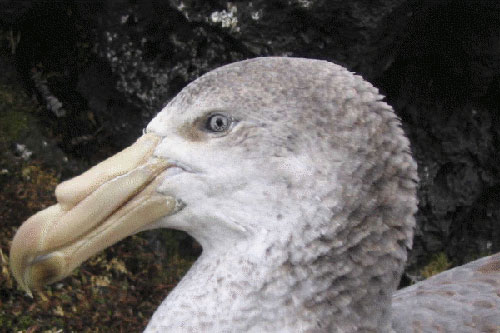

 English
English  Français
Français  Español
Español 